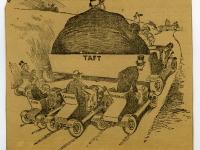Political cartoons are an excellent way to assess the popular culture of a particular time period. This lesson will combine history and language arts by asking students to examine various political cartoons in order to analyze point of view, symbolism, analogy, captions/labels, and irony, as is recommended in Pennsylvania’s Core Standards.
This lesson also will help students use their critical thinking skills to understand various historical events and, at the end of the lesson, students will have the opportunity to create their own cartoon. HSP has hundreds of political cartoons so if you find that you would like to use more, feel free to contact us for a full list of age appropriate cartoons for your classroom.


